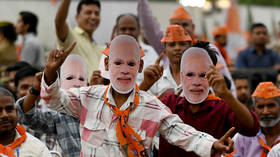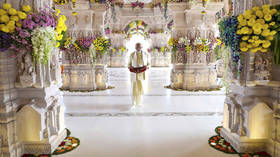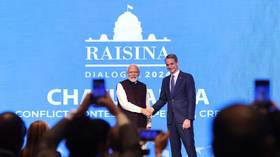India votes: How 970 million people are deciding on who the leader of world’s new powerhouse will be
The largest democracy starts weeks-long process to elect 543 members to its lower house of parliament and to determine the new PM
On Friday, India heads to the polling stations for the first of seven phases of its 18th Parliamentary elections, a process that will stretch until June 4. Around 968 million people –more than the population of the EU, US and Russia combined– are entitled to cast ballots to determine who gets to sit in India’s lower house of parliament, the Lok Sabha, and who will become India’s next prime minister.
The Lok Sabha, with 543 seats, is the more powerful lower house of Parliament. It passes laws, holds the government accountable by introducing and passing motions of no-confidence, holds the reins of financial control (having sole authority over taxation, borrowing, and spending), and wields more influence in legislative affairs.
Whichever party or coalition clinches a majority in the lower house gets to appoint the prime minister. As in the cases of former prime ministers Manmohan Singh or HD Deve Gowda, that appointee can also be a member of the Upper House, the Rajya Sabha. The prime minister then selects cabinet ministers.
The term of service in the Lok Sabha is five years, unless mid-term elections are called. To rule, a party or a coalition needs to secure at least 272 seats, though former PM PV Narasimha Rao ruled with a minority government, having won a vote of confidence in Parliament.
Who is contesting?
The ruling Bharatiya Janata Party (BJP) is competing against a coalition of more than a dozen opposition parties, including the Indian National Congress, commonly referred-to just as Congress, which once ruled over the nation for more than 50 years.
BJP, led by Prime Minister Narendra Modi, came to power in 2014, winning 282 seats (along with its allies in the form of the National Democratic Alliance, a total of 336 seats were secured). In 2019, BJP won 303 and the NDA took a total of 352 seats.
Modi, who first rose to power in 2014 on the promise of economic reform and a Hindu nationalist mandate, is at the center of this years’ contest. If he wins again, Modi will match the record of India’s first prime minister, the Congress leader Jawaharlal Nehru, by staying in office for three consecutive terms.
The BJP stated aim is to win 370 seats for itself – this number was the same as the Constitutional article governing Jammu and Kashmir that was struck down on August 5, 2019. Also, 364 seats in the Lok Sabha are required for major/structural Constitutional changes. The BJP has stated that it expects the NDA to win 400 seats. The Opposition predicts less than half of that for the ruling party.
Congress, the oldest party in the country, will contest the 2024 elections from the position of having the lowest number of seats in its electoral history. Congress has so far announced its candidates for only 266 seats, but is expected to field candidates in 330 to 340 constituencies. In 2019, Congress won just 52 seats – it didn’t allow it to qualify for ‘Leader of Opposition,’ for which a party needs to win 10%, or 55 seats.
Modi’s fiercest opponent and Congress’s key campaigner is Rahul Gandhi, the 52-year-old scion of India’s oldest political dynasty; his great-grandfather Jawaharlal Nehru, his grandmother Indira Gandhi, and his father Rajiv Gandhi, were all prime ministers of India. Gandhi himself, however, has never been a minister in a federal or state government. He quit as party chief after the 2019 election failure.
In 2023, 26 opposition parties joined Congress to form the Indian National Developmental Inclusive Alliance (INDIA). Some of the bloc’s other prominent parties include the Aam Aadmi Party (AAP), which currently rules in the Delhi region and the state of Punjab (its leader Arvind Kejriwal was remanded in judicial custody weeks ahead of polls, on corruption charges).
The left-wing Communist Party of India (Marxist), or CPI (M), which leads the ruling Left Democratic Front in the southern Indian state of Kerala; The Trinamool Congress (TMC) which is primarily active in the state of West Bengal; The Dravida Munnetra Kazhagam (DMK), led by Tamil Nadu Chief Minister MK Stalin and particularly influential in that southern state.
Election schedule
The election is in sevenphases, the first phase starting on April 19. Polling in it will cover 102 constituencies spread across 21 states and Union Territories (UTs).
These are: Arunachal Pradesh, Assam, Bihar, Chhattisgarh, Madhya Pradesh, Maharashtra, Manipur, Meghalaya, Mizoram, Nagaland, Rajasthan, Sikkim, Tamil Nadu, Tripura, Uttar Pradesh, Uttarakhand, West Bengal, Andaman and Nicobar Islands, Jammu and Kashmir, Lakshadweep and Puducherry. Out of these, ten states and union territories will be fully polled during the first phase, with 11 of them partially covered.
Notably, Assembly Elections in the north-eastern states of Arunachal Pradesh and Sikkim will also be held along with the first phase of Lok Sabha polls on April 19. The second phase of polling will be held on April 26, covering 89 parliamentary constituencies across 13 states.
Technology
India has used electronic voting machines (EVMs) extensively since the early 2000s. It introduced the technology during a by-election in 1982, when the machines were deployed in the Parur Assembly Constituency in Kerala.
The Election Commission developed the country’s indigenous EVMs in alliance with two state-owned entities operating under the Ministry of Defence – the Electronics Corporation of India and Bharat Electronics Limited. The EVMs are produced without any technical collaboration with a “foreign establishment” and the devices are “completely non-tamperable,” according to the government.
India will use about 5.5 million EVMs in this election, according to the Chief Election Commissioner Rajiv Kumar.
An EVM consists of a control unit and a balloting unit connected by cable. The control unit belongs to a polling officer while the balloting unit is kept in a compartment to cast votes. EVMs can be used in areas with no electricity, as they can be operated on alkaline batteries. Each system boasts a maximum voting capacity of 2,000 votes.
Through an EVM, a voter can cast their vote for the candidate of their choice or for the None of the Above (NOTA) option. The voting data recorded in EVMs can be retained for years and extracted if necessary.
Logistics
According to electoral regulations, there must be a polling station within a two-kilometer (1.2-mile) radius of every settlement. This requirement necessitates extensive journeys for many of the nation’s 11 million election workers, who traverse glaciers, deserts, jungles, carrying EVMs on horse and elephant back to ensure that all eligible citizens can cast their votes.
Since 2007, even the lone resident of the remote Gir National Park in Gujarat, where the last free-roaming Asiatic lions reside, has his own dedicated polling station equipped with an electronic voting machine. The resident is Mahant Haridasji Udasin, a priest at a Shiva temple located in the area. While there is no political campaigning there due to fear of wild animals, in 2019 a polling team of ten persons traveled over 15 miles (25 km) to set up a booth for a single voter, a PTI report notes.
Another team of polling officers in 2019 trekked more than 300 miles (482 km) of winding mountain roads and river valleys to reach another lone voter in Malogam, a remote hamlet in Arunachal Pradesh, close to the border with China.
According to Chief Election Commissioner Rajiv Kumar, the polling parties carry EVMs over the farthest and toughest terrain, crossing makeshift bridges to ensure “No voter is left behind.”
Funding and expenses
One of Election Commission’s key responsibilities is monitoring poll expenditure, both by parties and individual candidates. While there is no cap on how much parties can spend, candidates are limited to 9.5 million rupees ($114,000) per constituency. Generally, each party looks for candidates that can spend their own money.
Some of the big spenders, it’s speculated, may spend a half billion rupees ($6 million) or more on each constituency.
In the 2019 election, the authorities seized 33.77 billion rupees ($405 million) around the country that was earmarked for unauthorized spending in elections.
Political funding has become a hot topic ahead of the elections, particularly after February, when the Supreme Court scrapped the scheme for funding political parties – designed using electoral bonds purchased from the government-owned bank, State Bank of India. The scheme was introduced by the BJP government in 2018 to tackle corruption in Indian politics and make it more transparent. However, the country’s top court deemed it unconstitutional and ordered the Election Commission to make public all data provided by the bank.
The data revealed private donors provided about 120 billion rupees ($1.44 billion) to parties through the bond scheme. Half of that, 60 billion rupees ($719 million), went to the ruling Bharatiya Janata Party (BJP). The Congress party, as well as the All India Trinamool Congress (TMC) party, which is influential in the state of West Bengal, were among the next-biggest recipients. They raked in 14 billion rupees ($167 million) and 16 billion rupees ($191 million) in donations, respectively.
Why should the world care?
Foreign policy might have temporarily taken a back seat in India’s politics in the run up to the election, as former diplomat and RT contributor M K Bhadrakumar has pointed out, but New Delhi’s increasing weight on the global stage is a fact, making for even greater attention to the 2024 polls.
Earlier this week, Iran requested that India maintain an “active role” in efforts to halt the war in Gaza, through international bodies like the United Nations Security Council. The foreign minister of India was one of the first top diplomats to dial Tehran after its retaliatory attack on Israel. To be sure, New Delhi discussed the matter with both countries as it continues to maintain a delicate balance between Israel and Palestine – the same approach it applies to its engagement with Russia and the West, rapid economic growth and standing up for China, both at the border and more broadly – in its extended neighborhood.
India’s voice has become stronger not only when it comments on conflicts that have become a concern for humanity. New Delhi monitors, notes and responds to nearly every verbal attack, direct or veiled, made by its partners and adversaries. Its recent reaction to the US and Germany’s comments on the arrest of Delhi Chief Minister and opposition figure Arvind Kejriwal, its diplomatic spat with Toronto and Washington over Sikh activists in these countries – which India considers a big security threat – and for a reason, and its unprecedented move to increase its presence in the Arabian Sea and the Gulf of Aden, to respond to Houthi attacks and increased Somalian piracy, are some examples.
India last year conducted a mammoth geopolitical exercise of hosting the leaders of the G20 group of nations in New Delhi. Not only it impress world leaders with neat streets, top-level logistics and vegetarian food, it was instrumental in making the 55-state African Union a permanent G20 member, comprising the world’s richest and most powerful countries. It also forced the world’s top economic and political powers to reach a consensus on G20’s final communique, the Delhi Declaration, which, unlike its predecessor, the 2022 Bali Declaration, not only stops short of condemning Moscow for Ukraine crises, but doesn’t mention Russia at all in relation to the ongoing conflict.
New Delhi’s balancing act is not a new creation but a tradition, or a proven –though often flexible– tool that evolved after the Cold War from non-alignment into strategic autonomy, highlighting national interests as the top priority, as the country navigates the turbulent currents of geopolitics.
However, it is under the current leadership of India that the country’s foreign policy has become more muscular and more assertive. No doubt, India’s economic rise is one of the reasons – the country has become too big to ignore. It is the world’s most populous nation, having taken the crown from China last year, it is the world’s third largest importer of oil (and second biggest in Asia, after China), and is the largest arms importer.
At the same time, India is the world’s largest rice exporter, accounting for nearly 40% of total rice exports, the second largest exporter of beef (after Brazil), and the world’s fourth largest exporter of digitally delivered services (After the US, the UK, and Ireland). It is also the “pharmacy of the world” and the global center of diamond cutting and polishing.
Last year, Modi paid a first state visit to the US – the country he’d once been denied an entry visa for. President Biden and the First Lady hosted him at a historic state dinner in the White House. Modi addressed members of the US Congress, interacted with some of Silicon Valley’s top CEOs, including tech billionaire Elon Musk, who is expected to visit India this month to discuss starting the manufacture of Tesla cars in India.
Modi was Guest of Honour at France’s Bastille Day parade and repaid Emmanuel Macron by hosting him in India for its January 26 Independence Day parade (after Biden quietly declined the invitation).
Modi and his government policies have been praised by Russian officials, including President Vladimir Putin. The Russian leader last year noted that India is pursuing “an independent foreign policy, which is not easy in the modern world.” He added that “India has the right to do so,” and, under the leadership of Modi, it has effectively “exercised” this right. According to the Russian president, this has helped New Delhi’s partners build relationships that are predictable in both the short and long term.”There is tough, nationally-oriented leadership in the country,” Putin said.
New Delhi continues to maintain robust trade and diplomatic ties with Moscow despite criticism from the West. Foreign Minister Subrahmanyam Jaishankar, who is being continuously pressed by international media, commenters and politicians on India’s relationship with Russia, has argued that Moscow has never hurt New Delhi’s interests and that both nations took “extra care” of the ties. Jaishankar defended India’s foreign-policy choices as based on his “nation’s best interests.”
In his opening remarks at the Raisina Dialogue in New Delhi earlier this year, the country’s senior diplomat noted that India has transformed the annual event “from a regional to a global public square for dialogue and exchange of ideas – highlighting the new role New Delhi is playing now on the global stage.



